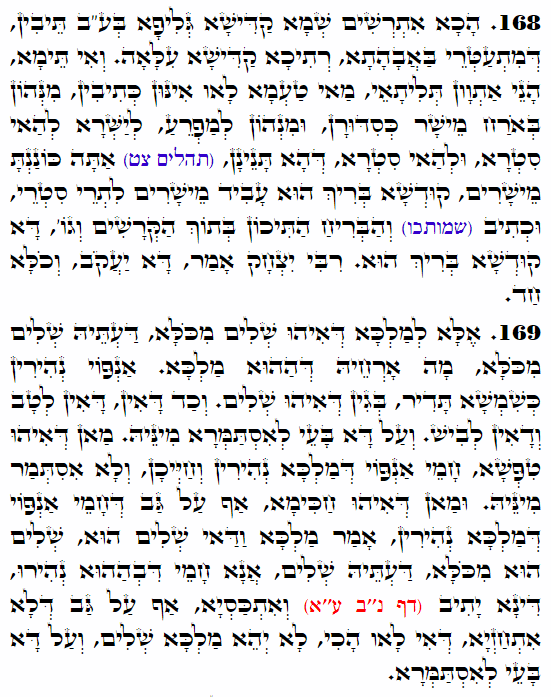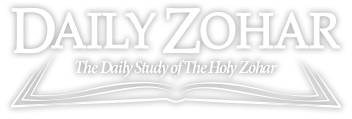Daily Zohar # 4461 – Beshalach – The king knows everything
Daily Zohar 4461

Hebrew translation:
169. אֶלָּא, לְמֶלֶךְ שֶׁהוּא שָׁלֵם מֵהַכֹּל, דַּעְתּוֹ שְׁלֵמָה מֵהַכֹּל, מַה דֶּרֶךְ אוֹתוֹ הַמֶּלֶךְ? פָּנָיו מְאִירוֹת תָּמִיד כַּשֶּׁמֶשׁ, מִשּׁוּם שֶׁהוּא שָׁלֵם. וּכְשֶׁדָּן, הוּא דָּן לְטוֹב וְדָן לְרַע, וְעַל זֶה צָרִיךְ לְהִשָּׁמֵר מִמֶּנּוּ. מִי שֶׁהוּא טִפֵּשׁ, רוֹאֶה אֶת פְּנֵי הַמֶּלֶךְ מְאִירוֹת וּמְחַיְּכוֹת וְלֹא נִשְׁמָר מִמֶּנּוּ. וּמִי שֶׁהוּא חָכָם, אַף עַל גַּב שֶׁהוּא רוֹאֶה שֶׁפְּנֵי הַמֶּלֶךְ מְאִירִים, אָמַר: הַמֶּלֶךְ וַדַּאי הוּא שָׁלֵם, שָׁלֵם מֵהַכֹּל, שָׁלֵם בְּדַעְתּוֹ, אֲנִי רוֹאֶה שֶׁבְּאוֹתוֹ הָאוֹר יוֹשֵׁב בְּדִין וְנִתְכַּסֶּה, אַף עַל גַּב שֶׁלֹּא נִרְאֶה, שֶׁאִם לֹא כָּךְ, לֹא יִהְיֶה מֶלֶךְ שָׁלֵם, וְלָכֵן צָרִיךְ לְהִשָּׁמֵר.
.
Zohar Beshalach
Continued from previous DZ
#168
The Holy Name is inscribed, engraved in seventy-two words. This means that the three sets of seventy-two letters from each of the three lines combine and intertwine, forming seventy-two words, each consisting of three letters from the three lines. These are adorned with the patriarchs, namely Chessed, Gevurah, and Tiferet, who are the upper Holy Chariot.
The question arises: Why is the third set of letters not written in two ways, some in straight order and some in reverse, to align with both the right and left sides, being that the middle line upholds the illumination of both sides? We have learned that “You have established equity” (Psalm 99:4), meaning that the Holy One, Blessed be He, creates uprightness and upholds both sides. It is written, ‘And the middle bar (הַבְּרִיחַ הַתִּיכוֹן) in the midst of the boards,’ (Exodus 26:28) which refers to the Holy One, Blessed be He, the middle line that upholds both sides. Thus, it should have been written half in the straight order, like the right line, and half in reverse, like the left line. Rabbi Yitzchak said, “The middle bar” is Jacob, and it is all one, for Jacob also represents the middle line.
#169
This can be compared to a king who is complete in all aspects and whose wisdom is perfect. The nature of such a king is that his face always shines like the sun due to his completeness. When he judges, he judges both for good and for bad. Therefore, one must be cautious around him. Seeing the king’s shining and smiling face, a fool does not guard himself. But a wise person, even though he sees the king’s face brightening, says, ‘Surely the king is complete in all aspects; his understanding is perfect. I see that within this brightness sits judgment, hidden, though not apparent. If it were not so, the king would not be complete.’ Therefore, one must be cautious.
{||}

 Previous: Beshalach
Previous: Beshalach
